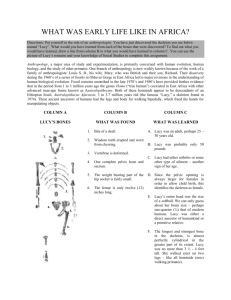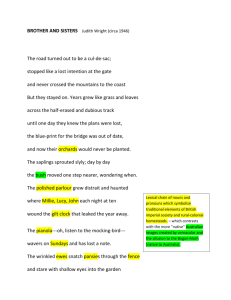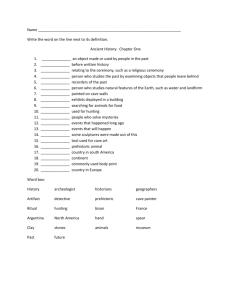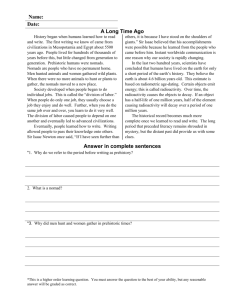"Lucy" Fact Sheet
advertisement
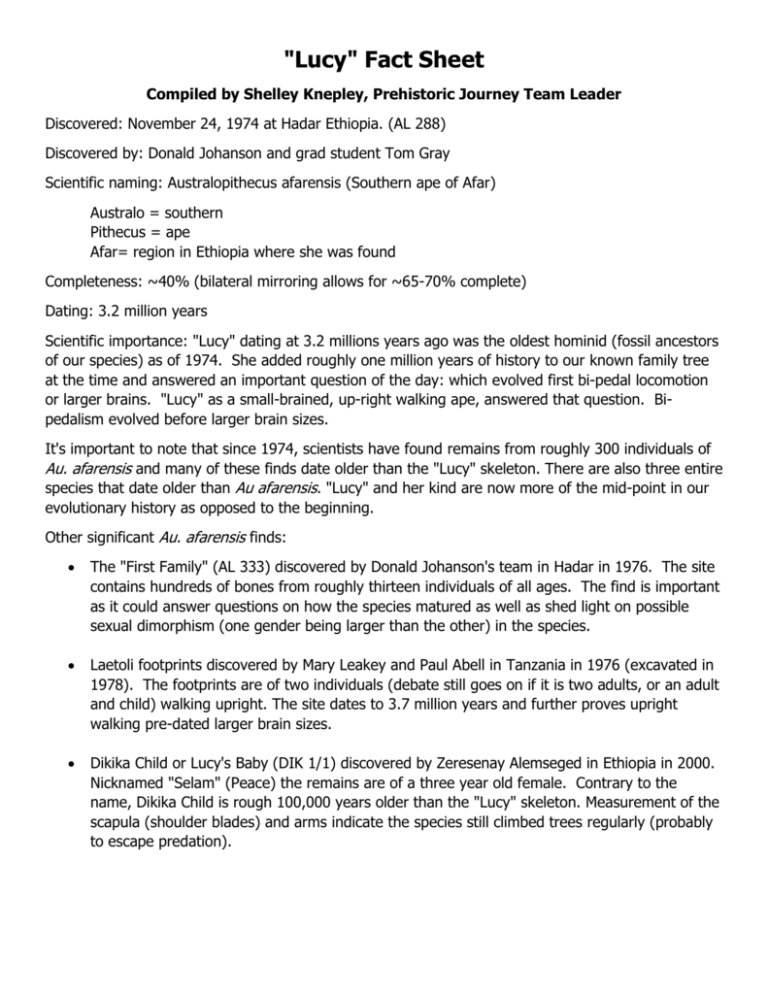
"Lucy" Fact Sheet Compiled by Shelley Knepley, Prehistoric Journey Team Leader Discovered: November 24, 1974 at Hadar Ethiopia. (AL 288) Discovered by: Donald Johanson and grad student Tom Gray Scientific naming: Australopithecus afarensis (Southern ape of Afar) Australo = southern Pithecus = ape Afar= region in Ethiopia where she was found Completeness: ~40% (bilateral mirroring allows for ~65-70% complete) Dating: 3.2 million years Scientific importance: "Lucy" dating at 3.2 millions years ago was the oldest hominid (fossil ancestors of our species) as of 1974. She added roughly one million years of history to our known family tree at the time and answered an important question of the day: which evolved first bi-pedal locomotion or larger brains. "Lucy" as a small-brained, up-right walking ape, answered that question. Bipedalism evolved before larger brain sizes. It's important to note that since 1974, scientists have found remains from roughly 300 individuals of Au. afarensis and many of these finds date older than the "Lucy" skeleton. There are also three entire species that date older than Au afarensis. "Lucy" and her kind are now more of the mid-point in our evolutionary history as opposed to the beginning. Other significant Au. afarensis finds: The "First Family" (AL 333) discovered by Donald Johanson's team in Hadar in 1976. The site contains hundreds of bones from roughly thirteen individuals of all ages. The find is important as it could answer questions on how the species matured as well as shed light on possible sexual dimorphism (one gender being larger than the other) in the species. Laetoli footprints discovered by Mary Leakey and Paul Abell in Tanzania in 1976 (excavated in 1978). The footprints are of two individuals (debate still goes on if it is two adults, or an adult and child) walking upright. The site dates to 3.7 million years and further proves upright walking pre-dated larger brain sizes. Dikika Child or Lucy's Baby (DIK 1/1) discovered by Zeresenay Alemseged in Ethiopia in 2000. Nicknamed "Selam" (Peace) the remains are of a three year old female. Contrary to the name, Dikika Child is rough 100,000 years older than the "Lucy" skeleton. Measurement of the scapula (shoulder blades) and arms indicate the species still climbed trees regularly (probably to escape predation). Common Questions about "Lucy" Q: Is she a girl? / How do we know she is female? A: Yes, she is female. Angle and position of pelvic bone (hips) determine gender Q: Is "Lucy" actual size? A: Yes, the forensic sculpture and the reconstructed skeleton are actual size (~3.5 feet tall) Q: Why is "Lucy" so small? A: This is most likely the result of diet. "Lucy's" species was herbaceous (plant eating) and mostly eating fruit, scientists know this from studying the dentition of Au. afarensis skulls. Increases in height (and brain size!) doesn't really take off until scavenging meat and later hunting enters the diet; scavenging around two million years ago, and hunting roughly one million years ago. "Lucy" may also be small as a result of sexual dimorphism (one gender being larger than the other). Male skeletons for the species are ~4.5 feet tall. Q: How old was "Lucy"? A: Studies of her teeth show "Lucy" was an adult when she died, however adulthood was much earlier for her species than for us; she was probably 11-12 years old. New research has changed the opinion that "Lucy" was elderly when she died, this was based on evidence of degenerative bone disease in the vertebrae. New findings suggest she was a mature adult, but still rather young at the time of her death. Q: How did "Lucy" die? A: We don't know, there isn't enough fossil evidence to say with any certainty. There is evidence of at least one bite mark on the bone, but no other signs of scavenging. The degenerative bone disease now does not appear to be the result of advanced age, either. The reality is we just will never know how she died. Q: Is "Lucy" a monkey? / Did we evolve from monkeys? A: "Lucy" and all other hominids (fossil ancestors of our species) are apes. We are related to other apes like a cousin; we didn't evolve from apes, we are an ape! Monkeys are a very distant relation; splitting off from the ape line of descent ~20 million years ago. An easy way to tell the difference between a monkey and an ape: monkeys have long tails, apes do not. Q: Is "Lucy" real? A: This is a question that means different things depending on the age of the person asking. Small children seem to really be asking, is she alive behind the glass. Older children/adults are asking if we really found anything that looked like her. Guests may also ask if the bone in the case is the actual bone; it is all reconstructed bone (specimens stay on the country of discovery). The actual fossil bone for "Lucy" is in the National Museum of Ethiopia in Addis Ababa.

